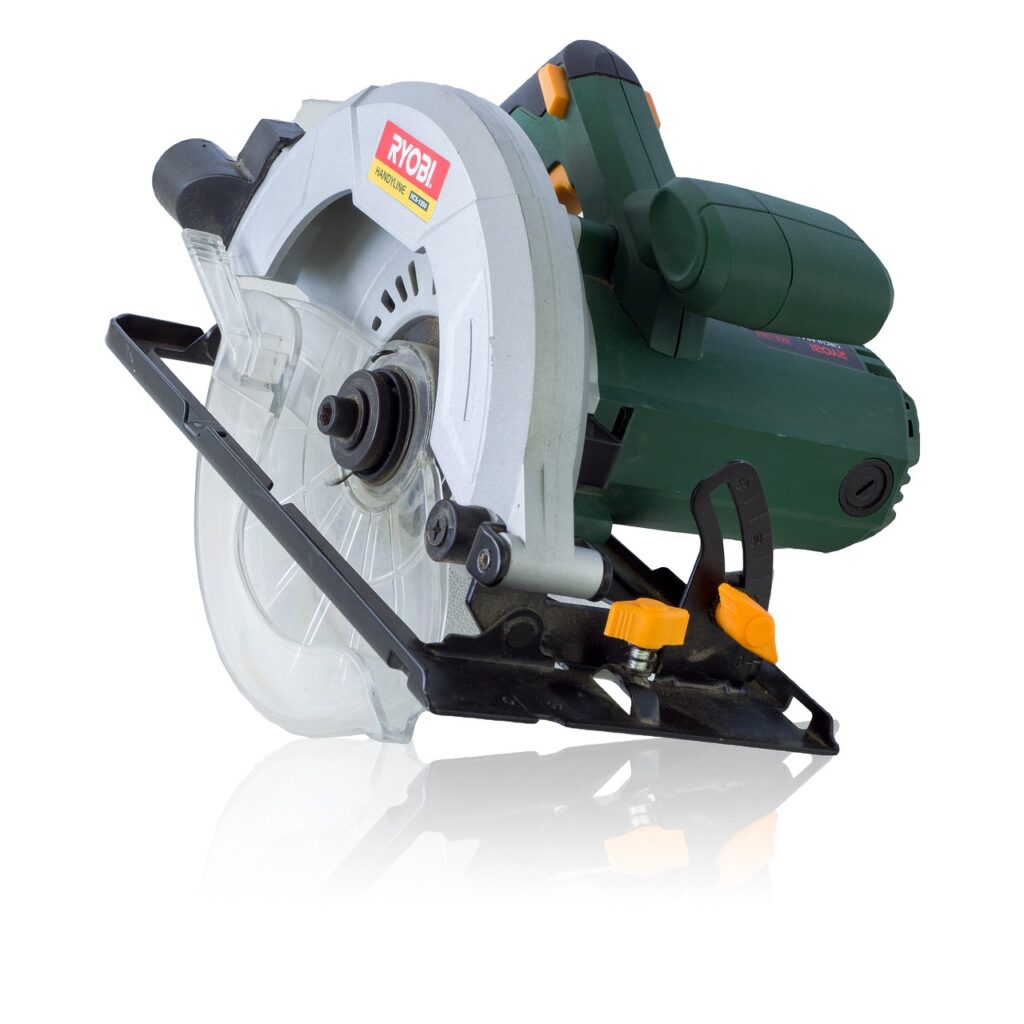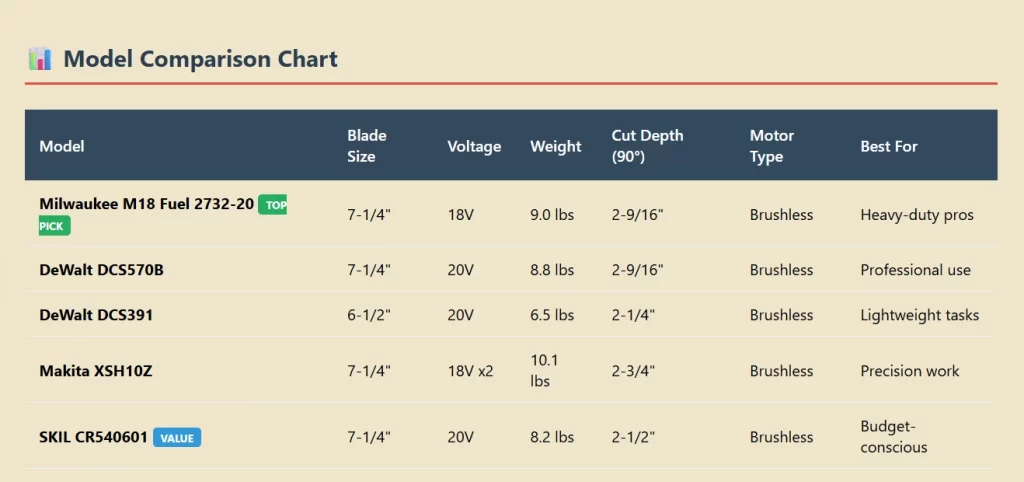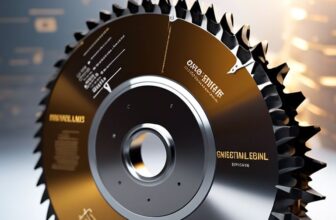Top cordless circular saws

You’re halfway through cutting a piece of lumber when your extension cord gets tangled around your leg, nearly sending you tumbling. Sound familiar? If you’ve ever wrestled with power cords while trying to make precise cuts, you’ll understand why cordless circular saws have become the go-to choice for smart DIYers and pros alike.
But here’s the thing – not all cordless saws are created equal. Some will power through a 2×4 like butter, while others struggle with a thin piece of plywood. So what separates the champions from the disappointments?
What Actually Makes These Things Work
If you’re like me, when you pick up a cordless circular saw, you want it to cut stuff without dying on you halfway through the job. It’s that simple. But the devil’s in the details, and understanding these details can save you from making an expensive mistake.
The Battery Game Changes Everything
Here’s something most people don’t realize until it’s too late: the battery matters way more than the saw itself. Think about it – you could have the most powerful motor in the world, but if your battery can’t keep up, you’re stuck with an expensive paperweight.
Most decent saws run on 18V or 20V batteries, which handle everyday tasks just fine. But if you’re planning to cut through thick lumber all day, you might want to look at the heavy hitters like the Metabo-HPT 60V system. These beasts deliver serious power without the weight penalty you’d expect.
And here’s a pro tip that’ll save you money: stick with battery systems you already own. Got a bunch of DeWalt 20V tools? The DeWalt DCS570B might be your best friend. Already invested in Milwaukee? Their M18 Fuel 2732-20 could be calling your name. Trust me, buying into multiple battery systems is like having three different types of phone chargers – it’s just asking for trouble.
Motors That Actually Mean Business
Remember those old circular saws that would overheat after twenty minutes? Yeah, those days are over – if you choose right. The secret sauce is brushless motors, and once you use one, you’ll wonder how you ever lived without it.
Take the Milwaukee M18 Fuel series, these things run cooler, last longer, and squeeze every bit of juice from your battery. It’s like the difference between an old gas-guzzling truck and a modern hybrid. Same job, way better efficiency.
Oh, and here’s something that might save your fingers someday: electronic brakes. The DeWalt DCS570B stops its blade in under three seconds. That might not sound impressive until you realize how long three seconds feels when a spinning blade is heading toward your hand.
Size Matters (But Not How You Think)
You’ve got two main choices: 6.5-inch blades or 7.25-inch blades. Now, you might think bigger is always better, but hold on.
The 6.5-inch saws are like the sports cars of the circular saw world – nimble, lightweight, and perfect for detailed work. If you’re doing trim carpentry or working in tight spaces, something like the DeWalt DCS391 will become your best friend. You can work overhead for hours without your arms turning to jelly.
But if you’re framing houses or cutting thick lumber, you’ll want the full-size 7.25-inch models. These can slice through a 2×4 in one pass, even at an angle. Sure, they’re heavier, but when you need that cutting depth, there’s no substitute.
The Real-World Performance Test
Let me tell you about three types of people and the saws that make them happy.
The Weekend Warrior
You know who you are – you tackle projects around the house, maybe build a deck, cut some shelving. You don’t need to impress anyone, you just want something reliable that won’t break the bank or your back.
For you, those compact 6.5-inch models are pure gold. They’re light enough to handle all day, powerful enough for your projects, and they won’t make you feel like you’re swinging a boat anchor around. The DeWalt DCS391 has saved countless weekend projects from turning into weekend disasters.
The Heavy-Duty Hero
Maybe you’re a contractor, or maybe you just take on projects that would make most people call a professional. Either way, you need a saw that can keep up with your ambitions.
This is where the big guns come out. The Milwaukee M18 Fuel 2732-20 has earned legendary status among pros for a reason – it cuts like a corded saw but goes anywhere you do. The DeWalt DCS570B runs at 5200 RPM and cuts 2-9/16 inches deep, which means it’ll power through just about anything you throw at it.
The Perfectionist
Some people don’t just want to cut wood – they want to cut it perfectly, every single time. If that’s you, you’re probably willing to pay a bit more for features that most people never think about.
The Makita XSH10Z is like the Swiss watch of circular saws. Yes, it costs more than some alternatives, but the precision and build quality are in a different league. When every cut needs to be perfect, this is what you reach for.

The Stuff Nobody Talks About (But Should)
Here’s where most articles stop, but we’re just getting to the good stuff. Let’s talk about the little things that separate a tool you love from one that sits in your garage collecting dust.
Safety Features That Actually Work
Modern cordless saws are loaded with features that would have seemed like science fiction twenty years ago. LED lights that actually illuminate your cut line (not just the general area), blade guards that don’t get in your way, and electronic brakes that stop faster than you can blink.
But here’s the thing – these features only work if you can actually use them comfortably. A saw that’s awkward to hold or poorly balanced will have you fighting the tool instead of focusing on the cut. When you pick up a well-designed saw like the DeWalt DCS570B, it just feels right in your hands.
The Maintenance Reality Check
Let’s be brutally honest – nobody enjoys maintaining tools. The good news is that cordless circular saws need very little babying. Keep the base plate clean (a dull chisel works great for scraping off built-up pitch), and make sure your blades stay sharp.
Speaking of blades – and this is important – even the best saw in the world is only as good as its blade. A dull blade will drain your battery faster, strain the motor, and give you rough cuts that require sanding. Sharp blades make everything easier.
Making the Call
So here’s where we get down to brass tacks. You’ve got your budget, you know what kind of projects you tackle, and you’re probably already invested in a battery system. Now what?
Recent testing has shown that the Milwaukee M18 Fuel 2732-20 consistently delivers impressive power and cutting depth, while the SKIL CR540601 offers surprisingly good performance at a fraction of the cost. If maximum runtime is your thing, the DeWalt 20V Max 7-1/4-Inch models have earned a reputation for going the distance.
But here’s the secret that tool reviewers don’t always tell you: the best saw is the one that fits your hands, works with your existing batteries, and handles your typical projects without drama. You can read specs all day long, but nothing beats picking up a saw and seeing how it feels.
That said, don’t get so caught up in power numbers that you forget about the basics. A saw that’s comfortable to use, has good visibility of the cut line, and stops quickly when you need it to is worth more than an extra half-inch of cutting depth you’ll never use.
The Bottom Line Truth
Look, I could throw more model numbers at you, or dive deeper into amp-hour ratings and torque specs. But at the end of the day, the best cordless circular saw is the one that makes you excited to start your next project instead of dreading the cutting phase.
Whether that’s a lightweight 6.5-inch saw that won’t wear you out, a full-power 7.25-inch beast that eats through lumber, or a precision instrument that delivers perfect cuts every time, the choice is yours. Just remember – sharp blades, charged batteries, and a saw that feels right in your hands will take you further than any spec sheet ever could.
The cordless revolution isn’t coming – it’s here. And once you experience the freedom of cutting anywhere without worrying about power outlets, extension cords, or generator noise, you’ll wonder how you ever got by without it.







